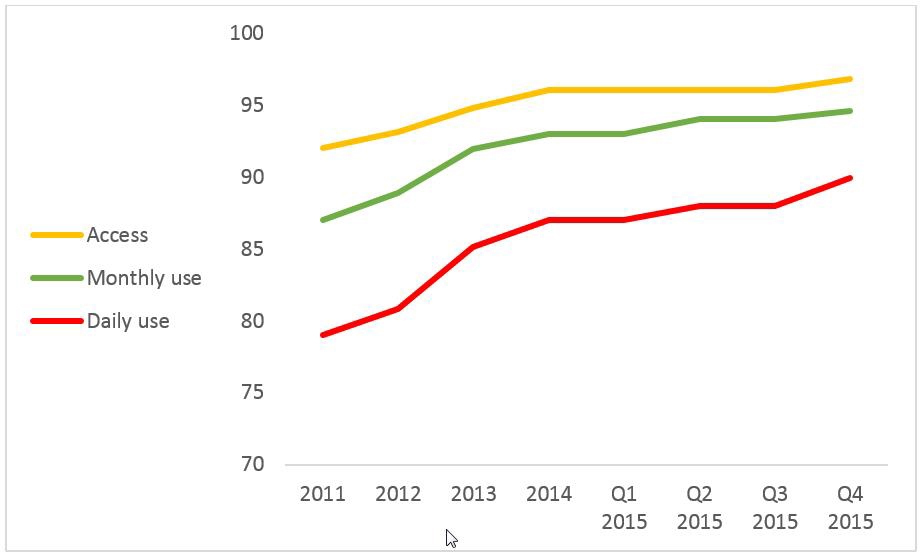4 Norway's digital performance
4.1 Digital life
When the previous white paper on ICT policy – Digital Agenda for Norway – ICT for Growth and Value Creation9 – was published, Norway was already a mature internet market. A large proportion of the population had access to internet, and a large proportion used the internet on a daily basis. Since then, Norway has maintained its position as one of the leading countries in this respect, and Norwegians' internet usage has continued to grow. Even more citizens have gained internet access, and more of them are using it daily.10
In 2015 Q4, 97 per cent of the population aged over 12 had internet access at home, at school or work, or elsewhere. 90 per cent were using the internet daily. In 2011, 92 per cent had internet access and 79 per cent were using the internet on an everyday basis.11

Figur 4.1 Figure 4.1 Proportion of the population with internet access, as percentage using the internet monthly and daily.
Kilde: Source: TNS Gallup Forbruker & Media.
The average broadband speed has increased markedly. There have also been changes in the choice of device we use to connect with the internet. Smartphones and tablets have made their entry during this period, see figure 4.2

Figur 4.2 Figure 4.2 Proportion of the population with access to smartphones and tablets in 2011 and 2015.
Kilde: Source: TNS Gallup Interbuss 2011 Q2 and 2015 Q4.
The growth in digital infrastructure has made use of digital services an integrated part of everyday life.
Digitisation is manifesting itself in new behaviour and new expectations in several areas. For example, we are now online 24 hours a day, and we expect information to be accessible online whenever we want it.
We also spend more time online, from 112 minutes in 2013 to 120 minutes in 2014. The population's average time spent online has never been higher.12
ICT usage in industry
Statistics Norway publishes annual figures on ICT usage in industry.13 The survey shows clear differences in ICT usage between small and large enterprises, the largest being the most active users. Furthermore, Statistics Norway's surveys show that use of social networks such as Facebook and LinkedIn by enterprises with at least 10 employees has steadily increased over the past two years. In 2015, six of 10 enterprises used social networks. Statistics Norway's survey also shows that the proportion of enterprises using cloud services rose from 29 per cent in 2014 to 38 per cent in 2015. The proportion of enterprises with fast broadband has also risen steadily in recent years. In 2011, 17 per cent of enterprises had broadband with a minimum download speed of 30 Mbit/s, whereas in 2015 this proportion was 37 per cent. In 2015, 80 per cent of enterprises had their own website.